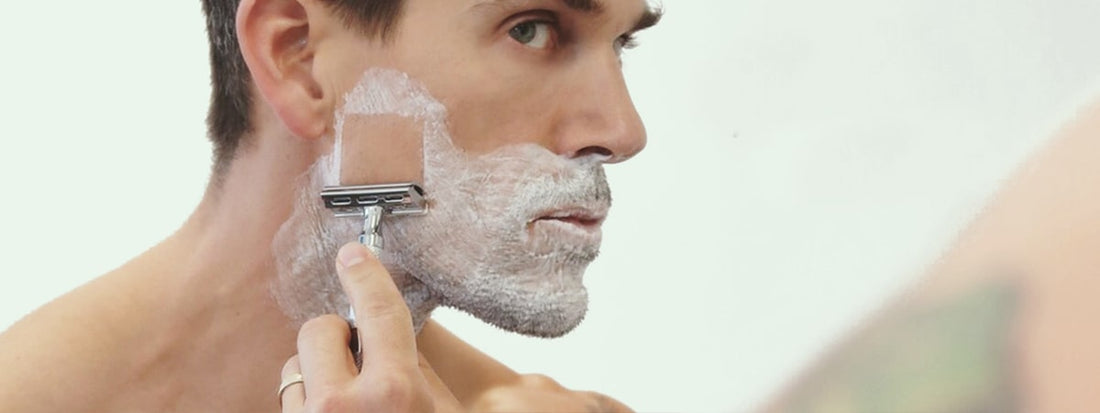If you have sensitive skin you know the problems shaving can bring. You think you have a great shave, then you return to the bathroom for some last minute adjustments before heading to work, and there it is. Red bumps around your neck. Your cheeks feel burned and are flushed. Your aftershave stings more than peroxide on a cut. Don't you wish there was a way to avoid these kinds of shaving problems, having a comfortable, quality shave, and return to the bathroom without a bombardment of red skin and dots? It's all possible, and Rockwell Safety Razors can help, along with some helpful tips.
Shower First
Don't go into your shave cold turkey. You need to prep your skin and showering is the best way to do this. Thanks to the hot water and steam your skin's pores will open up. This makes it easier for a razor to glide over your skin and not face the kind of resistance it usually puts up. Even if you only have time for a few minutes of a shower, it's often all the difference.
Exfoliate Your Skin
While you're showering make sure to exfoliate your skin. If you suffer from razor bumps or ingrown hairs, dead skin can oftentimes be a culprit and leave you with a not-so-smooth shave. To avoid this problem you'll want to wash your face and clean off the pores. Picking up a shave brush will help exfoliate and clean up the dead skin and grime and prep you skin and hair for a far superior shave.
Use a Mild Shave Setting
This is one the most important factors in achieving a comfortable, irritation-free shave. Rockwell Razors thoughtfully engineered every blade angle setting to serve a purpose. By shaving on the milder shave settings (R1 - R3), you'll be able to limit the amount of blade exposure and change the angle of the blade to be less aggressive. Sizes R1 and R2 are perfect for those with sensitive skin or are prone to nicks, cuts and shave irritation. Investing in a durable, adjustable safety razor can make all the difference.
Shave With a Fresh Blade
Older razor blades cause your skin to break out. The older razor drags and pulls along your skin instead of cutting hair at the base. The dull blade does not cut as well and also increases the chance of experiencing a razor bump or ingrown hair. Not to mention that used blades can oftentimes be a breeding ground for bacteria that can make the problem worse. To avoid these problems, swap out your blade every few shaves.
Of course, with cartridge razors this becomes expensive. A new blade every few shaves will set you back hundreds of dollars a year. That's not the case with Rockwell Safety Razors - you can pick up a brand new blade for as little as 12 cents. Plus, we use premium Swedish stainless steel blades that retain an exceptional sharpness for longer.
After Razor Care
If you have sensitive skin you might break out in a rash after the shave. The rash might remain for only a few minutes or it might last for the majority of the day. However long the rash remains it's typically there because your skin is reacting to the metal of the blade.
First, you need a high-quality blade. Other companies may use nickel in the blade and cartridge production. Nickel is known to cause skin rashes and breakouts (if you've ever bought your girlfriend a necklace and her chest broke out after wearing it, it's because the necklace was likely gold or silver plated with nickel as the core).
Next, you'll need to take care of the razor blade after cleaning. Rockwell Razors blades are specially treated to be rust-proof. However, If not cared for, some brands of double-edge blades blade can rust, even if you do not immediately see the rust. Running a rusty blade across your face is enough to make anyone's skin break out. So completely rinse off the blade after a shave. Remove it from the double edge razor and dry it off with a clean towel. You'll want to dry off the razor as well. This way, moisture does not collect in the razor, leading to the deterioration of the blade.
Use a Pre-Shave Oil
If you continue experiencing irritation, it could be that a pre-shave oil is exactly what your regimen is missing. Pre-shave oil is for those with particularly stubborn facial hair or are predisposed to cuts, ingrown hairs or razor burn. After locking in moisture and softening, nourishing and massaging the skin and hair with a pre-shave oil, you'll wonder how you ever shaved without it.
After Shave and Moisturizer
Following your shave make sure to use an aftershave. This offers your skin nourishing moisture for a raw, freshly shaved area. Using an all-natural post-shave balm is paramount - while being mindful to avoid any alcohol-based, drying or abrasive ingredients you can't pronounce.
By following these different tips, you should for now on avoid the problems of shaving with sensitive skin. After all, no matter your skin type, sensitivity or facial hair thickness, you deserve to enjoy your shave.
Put an end to your shaving problems for good with the Rockwell 6C Shave Kit. Comes with our all-natural Rockwell Shave Cream and Rockwell Synthetic Shave Brush.
